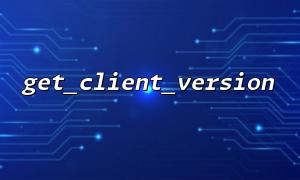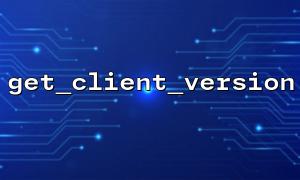In the background management system, understanding the version information of the client is very useful in many scenarios. for example:
Determine whether the client is the latest version and whether it requires a forced upgrade;
Record access logs for troubleshooting;
Return different data structures according to version differences to ensure compatibility.
This article will introduce how to apply a function called get_client_version in the PHP background management system to identify and obtain client version information.
Client version information is generally actively passed by the front-end (such as App or Web client) through HTTP headers or parameters when requested, for example:
User-Agent: MyApp/2.3.1 (iOS)
Or customize the header:
X-Client-Version: 2.3.1
We can extract the version number from this information and make business judgments based on it.
We first define a common get_client_version function, which will give priority to obtaining version information from the X-Client-Version Header. If not set, try parsing from the User-Agent .
/**
* Get the client version number
*
* @return string|null
*/
function get_client_version(): ?string {
// Priority to customization Header
$headers = getallheaders();
if (isset($headers['X-Client-Version'])) {
return trim($headers['X-Client-Version']);
}
// Try from User-Agent Analysis
if (isset($_SERVER['HTTP_USER_AGENT'])) {
if (preg_match('/MyApp\/([\d\.]+)/', $_SERVER['HTTP_USER_AGENT'], $matches)) {
return $matches[1];
}
}
return null;
}
Tip: You can adjust regular expressions according to the specific implementation of the front-end.
Suppose we are developing an API interface /api/dashboard , and we need to judge the client version to determine the returned data format:
// dashboard.php
require_once 'utils.php'; // Assumptions get_client_version Write in this file
$version = get_client_version();
if ($version === null) {
http_response_code(400);
echo json_encode(['error' => 'Unable to recognize the client version']);
exit;
}
// Judgment version
if (version_compare($version, '2.0.0', '<')) {
// Return to the old version of the data structure
$response = [
'message' => 'Please upgrade the client to get full functionality',
'data' => [],
'upgrade_url' => 'https://gitbox.net/app/update'
];
} else {
// Return to the new version of the data structure
$response = [
'message' => 'Welcome to the latest version',
'data' => [
'stats' => [/* Statistics */],
'notifications' => [/* Notification information */],
]
];
}
header('Content-Type: application/json');
echo json_encode($response);
The front-end should bring version information every time it requests, such as adding a header to the Axios request interceptor:
axios.defaults.headers.common['X-Client-Version'] = '2.3.1';
Or add the version number when constructing the User-Agent string:
navigator.userAgent = 'MyApp/2.3.1 (Android)';
Through the get_client_version function, we can easily obtain the client's version information in the PHP background system, thereby realizing version control, function diversion and other operations. Combined with the unified and standardized delivery of version information at the front end, this mechanism can greatly enhance the robustness and maintainability of the system.
Do I need to provide a sample unit test of this function?















